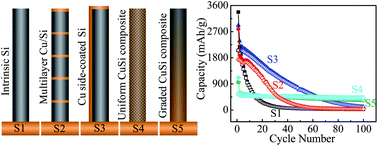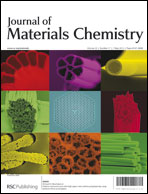To target the low conductance and stress issues of Si anodes for rechargeable Li-ion batteries, we have systematically designed four unique Si nanorod-based anodes using a dynamic shadowing growth method. Multilayer Cu/Si and Cu side-coated Si nanorods serve to improve the conductance, meanwhile, uniform CuSi and composition-graded CuSi nanocomposites serve to relax the stress and increase the conductance. Under the identical charge/discharge conditions, both the uniform and graded CuSi composite nanostructures exhibit the best cycling performance with capacity retention of 60–80% after 100 cycles of Li-ion insertion and extraction. The morphology evolution reveals that the nanorod wall-like structures remain intact in the uniform and graded CuSi composite anodes, while they have peeled off from the current collectors in the intrinsic Si, multilayer Cu/Si, and Cu side-coated Si samples. The morphological changes of different Si-based nanoanodes have also been modeled by a beam network, revealing that Si-based composite nanostructures generate a low yield stress which could be the key to developing high performance Li-ion battery anodes.

You have access to this article
 Please wait while we load your content...
Something went wrong. Try again?
Please wait while we load your content...
Something went wrong. Try again?


 Please wait while we load your content...
Please wait while we load your content...